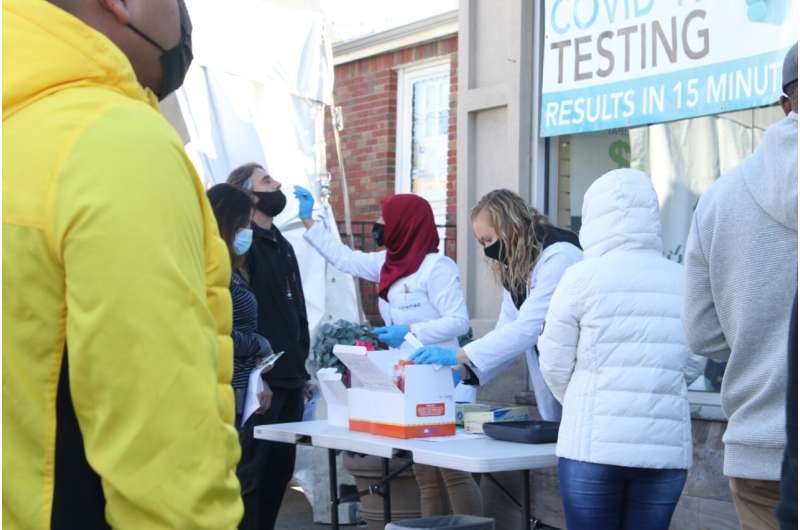
Many people are worried about reports of “breakthrough” COVID-19 infections overseas, from places like Israel and the United States.
A breakthrough infection is when someone tests positive for COVID after being fully vaccinated, regardless of symptoms.
The good news is most breakthrough infections usually result in mild symptoms or none at all, which shows us that vaccines are doing exactly what they’re supposed to do—protecting us from severe disease and death. Vaccines aren’t designed to protect us from getting infected at all (known as “sterilizing immunity”).
People with breakthrough infections can go on to infect others. Preliminary evidence indicates immunized people can have high levels of virus in the nose, potentially as high as unvaccinated people.
However, if you’re vaccinated you’ll clear the virus more quickly, reducing the length of time you’re infectious and can pass the virus on.
Here’s why breakthrough cases are happening, and why you shouldn’t worry too much.
Two studies from the United Kingdom suggest the immunity we get from COVID vaccines wanes over time, after about four to six months.
While the more-infectious Delta variant continues to circulate, waning immunity will lead to more breakthrough infections.
But the reduction isn’t large currently. Vaccine effectiveness is very high to begin with, so incremental reductions due to waning won’t have a significant effect on protection for some time.
Israeli data shows some vaccinated people are becoming ill with COVID. But we need to keep in mind Israel’s vaccine rollout began in December 2020, and the majority of the population were vaccinated in early 2021. Most are now past six months since being fully vaccinated.
Given most people in Israel are vaccinated, many COVID cases in hospital are vaccinated. However, the majority (87%) of hospitalized cases are 60 or older. This highlights what’s known about adaptive immunity and vaccine protection—it declines with age.
Therefore we’d expect vulnerable groups like the elderly to be the first at risk of disease as immunity wanes, as will people whose immune systems are compromised. Managing this as we adjust to living with COVID will be an ongoing challenge for all countries.
What would be concerning is if we started seeing a big increase in fully vaccinated people getting really sick and dying—but that’s not happening.
Globally, the vast majority of people with severe COVID are unvaccinated.
We’ll probably need booster doses
Waning immunity means booster doses will likely be needed to top up protection, at least for the next couple of years while the virus continues to circulate at such high levels.
Our currently approved vaccines were modeled on the original strain of the virus isolated in Wuhan, not the Delta variant, which is currently dominant across most of the world. This imperfect match between vaccine and virus means the level of protection against Delta is just a little lower.
Because the level of effectiveness is so high to begin with, this small reduction is negligible in the short term. But the effects of waning over time may lead to breakthrough infections appearing sooner.
mRNA vaccines in particular, like Pfizer’s and Moderna’s, can be efficiently updated to target prevalent variants, in this case Delta. So, a third immunization based on Delta will “tweak,” as well as boost, existing immunity to an even higher starting point for longer-lasting protection.
We could see different variants become endemic in different countries. One example might be the Mu variant, currently dominant in Colombia. We might be able to match vaccines to whichever variant is circulating in specific areas.
The dose makes the poison
Your level of exposure to the virus is likely another reason for breakthrough infections.
If you’re fully vaccinated and have merely fleeting contact with a positive case, you likely won’t breathe in much virus and therefore are unlikely to develop symptomatic infection.
But if you’re in the same room as a positive case for a long period of time, you may breathe in a huge amount of virus. This makes it harder for your immune system to fight off.
This may be one reason we’re seeing some health-care workers get breakthrough infections, because they’re being exposed to high viral loads. They could be a priority for booster doses.
Might unvaccinated kids be playing a role?
It’s unclear if children are contributing to breakthrough infections.
Vaccines aren’t approved for young children yet (aged under 12), so we’re seeing increasing cases in kids relative to older people. Early studies, before the rise of Delta, indicated children didn’t significantly contribute to transmission.
More recent studies in populations with vaccinated adults, and where Delta is the dominant virus, have suggested children might contribute to transmission. This requires further investigation, but it’s possible that if you’re living with an unvaccinated child who contracts COVID, you’re likely to be exposed for many, many hours of the day, hence you’ll breathe in a large amount of virus.
The larger the viral dose, the more likely you’ll get a breakthrough infection.
Potentially slowing the number of breakthrough infections is one reason to vaccinate 12 to 15 year olds, and younger children in the future, if ongoing trials prove they’re safe and effective in this age group. Another is to protect kids themselves, and to get closer to herd immunity (if it’s achievable).
A silver lining
Breakthrough infections likely confer extra protection for people who’ve been fully vaccinated—almost like a booster dose.
We don’t have solid real-world data on this yet, but it isn’t surprising as it’s how our immune system works. Infection will re-expose the immune system to the virus’ spike protein and boost antibodies against the spike.
However, it’s never advisable to get COVID, because you could get very sick or die. Extra protection is just a silver lining if you do get a breakthrough infection.
As COVID becomes an endemic disease, meaning it settles into the human population, we’ll need to keep a constant eye on the interaction between vaccines and the virus.
Source: Read Full Article